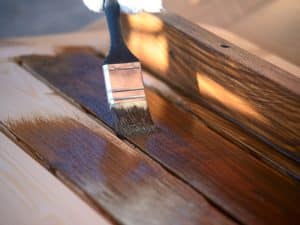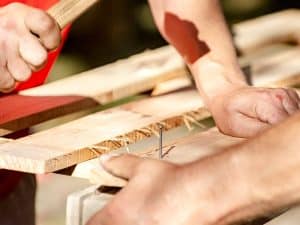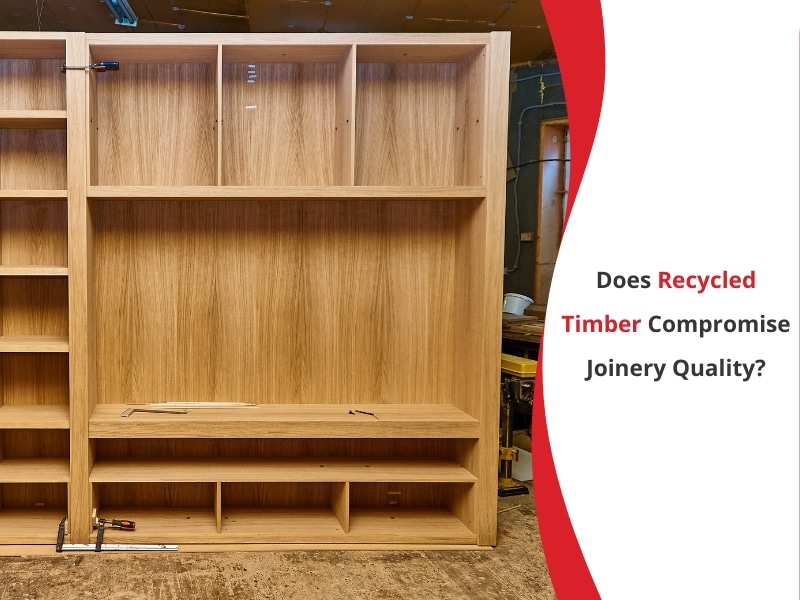Recycled timber has gained popularity for its environmental benefits and unique character. However, some might wonder if recycled wood is up to the task of joinery—where precision and durability are crucial. This article explores whether recycled timber compromises joinery quality by examining its properties, strength, aesthetic potential, sourcing, techniques, environmental benefits, and cost.
What is recycled timber joinery?
Recycled timber joinery uses timber reclaimed from old buildings, structures, or furniture in new joinery projects. It involves repurposing timber already serving a previous function, giving it a new lease on life.
Here are some key aspects:
- Source: Timber is typically sourced from demolished or renovated buildings, old furniture, or industrial sites.
- Preparation: The timber is cleaned, de-nailed, and processed to be suitable for new joinery projects.
- Quality: The quality of recycled timber can vary depending on its original use and condition.
Does it have the same strength as the new timber for the joinery?
Strength is super important when you’re building stuff with wood. New timber is usually the go-to choice, but what about recycled timber? Can it hold up?
- Old wood, new tricks: Some old timber is more potent than new stuff. Why? Because the trees they came from grew slower and ended up denser. It’s like comparing a bodybuilder to a couch potato.
- Check it out: Before you use recycled timber, you need to give it a good look-over. Look for cracks, splits, or other damage that could weaken it.
- Give it a boost: Recycled timber often needs extra love to be as strong as new timber. This might mean treating it with something to protect it or fixing any damage.
So, can you use recycled timber for your joinery project? Maybe! It depends on what you’re making and the condition of the wood.
Can recycled timber achieve the desired aesthetic outcomes in joinery?
Looks matter. Old wood can be super cool, but it can be better for building stuff. Here’s the deal:
- It’s got character: Old wood often has excellent marks and colours. It can make your stuff look really unique and quite old-school.
- Not always the same: Every piece of old wood is different, and making things look exactly alike can be difficult.
- You can fix it up: You can paint or stain old wood to make it look how you want.

- Work with it, don’t fight it: Sometimes, the cool thing is to let the old wood be itself. A good builder can make it look awesome.
Are there specific joinery techniques better suited for recycled timber?
Specific woodworking techniques can optimise the performance and appearance of recycled timber.
- Reinforcement: Additional reinforcements, such as metal brackets or dowels, can help enhance the strength and stability of recycled timber joinery.
- Custom fitting: Custom joinery techniques can accommodate the unique characteristics of recycled timber, such as irregularities in size or shape.
- Finish: Specific finishing techniques can help highlight the timber’s natural beauty while protecting against wear and tear.
How does the sourcing and processing of recycled timber impact joinery quality?
The sourcing and processing of recycled timber play a significant role in its quality and suitability for joinery. Key factors include:
- Source quality: Timber from well-maintained structures or high-quality original materials tends to be better suited for joinery.
- Processing: Proper processing is crucial to removing contaminants, ensuring structural integrity, and preparing the timber for use.

- Sourcing practices: Ethical and sustainable sourcing practices can influence the overall quality of recycled timber.
What are the environmental benefits of recycled timber joinery?
Recycled timber joinery offers several environmental benefits, making it a sustainable choice for many projects. Here are some advantages:
- Resource conservation: Reusing timber reduces the need for new resources, helping to preserve forests and minimise waste.
- Energy savings: Processing recycled timber requires less energy than producing new timber, reducing overall environmental impact.
- Waste reduction: By repurposing old timber, we reduce the amount of construction and demolition waste that ends up in landfills.
How does the cost compare to traditional timber?
Cost is an essential consideration for any joinery project. Recycled timber often presents a different cost profile compared to traditional new wood. Here’s what to consider:
- Upfront cost: Recycled wood can cost more than fresh-cut wood. It takes extra work to clean and prepare it for use, and some kinds of recycled timber are rare so they can be pricey.
- Long-term value: Here’s the thing: recycled wood can save you money in the long run. It’s got character, it’s eco-friendly, and it can make your project look cool. People might even pay more for something made with recycled wood.
- Availability and price tag: The price of recycled wood can change depending on what’s out there and what people want. Some types are super popular and cost more, while others are more common and cheaper.
Other stuff to think about:
- Waste: You might waste more recycled wood while working with it because it can be better.
- Labour: Hiring someone to work with recycled wood might cost more because it takes special skills.
- Finishing touches: Getting recycled wood to look how you want might need extra work and money.
So, is recycled wood worth it? It depends on what you’re after. Weigh the pros and cons and see if it fits your budget and style.
Conclusion
Recycled timber can be a viable option for joinery, offering both challenges and benefits. It’s essential to assess the timber’s strength, aesthetic potential, and processing to ensure it meets the requirements of your project. With careful selection and appropriate techniques, recycled timber can provide high-quality, sustainable joinery solutions.
Transform your space with a sustainable style
If you’re considering recycled timber for your next joinery project, Inspired Joinery & Maintenance in Sydney is here to help. Our team of experts can guide you through selecting the right materials, applying suitable techniques, and achieving exceptional results. Contact Inspired Joinery & Maintenance today to discuss your project and discover how we can enhance your joinery.




